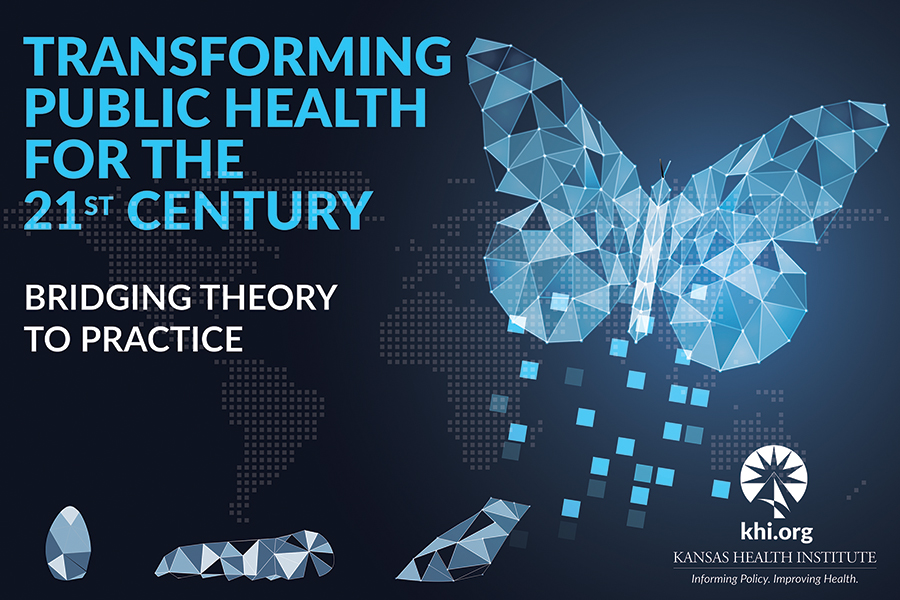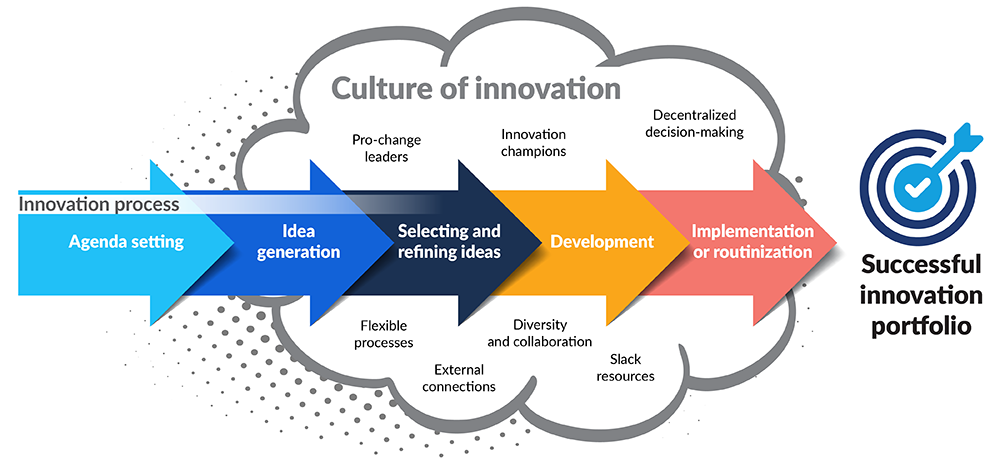The Kansas Health Institute (KHI), functioning as the Region 7 Public Health Innovation Hub, is one of 10 regional technical assistance centers offering dedicated support to recipients of the Public Health Infrastructure Grant (PHIG) which is funded by the Centers for Disease Control and Prevention (CDC). Working under the leadership of the National Network of Public Health Institutes (NNPHI), KHI works to strengthen public health infrastructure and support public health innovation in Region 7, which includes Kansas, Iowa, Missouri and Nebraska.
Meeting the Need for Innovation in Public Health: Crafting a Culture and Process for Innovation

Transforming Public Health for the 21st Century: Bridging Theory to Practice is a blog series that will explore the challenges and opportunities faced by the public health sector and will introduce a roadmap for transformation. Sign up here to receive these summaries and more, and also follow KHI on Facebook, Twitter, LinkedIn, and Instagram. Learn more about the series on our archive page. Please feel free to share your feedback or suggestions with us by emailing info@khi.org.
In a previous post, we highlighted the significance of adopting a portfolio approach for public health innovation. In this post, we delve deeper into the topic of innovation, exploring what a culture and process of innovation might look like in public health. Innovation can help solve deep-seated public health challenges and there is a desire among many public health professionals to work in innovative organizations. As such, we hope this blog post helps to guide public health leaders as they craft a culture and process for innovation.
A Culture of Innovation
Culture encompasses the beliefs, values, attitudes, behaviors and practices that define how an organization operates. A culture of innovation reduces ties to the status quo and eases the innovation process. Innovation is fundamentally a creative process that challenges team members to expand their imagination and experiment with new approaches. It seldom takes the path of least resistance, as numerous factors favor maintaining the status quo. However, organizations committed to innovation deliberately shape their culture to foster and encourage fresh ideas.
Everett M. Rogers, in his seminal work “Diffusion of Innovations,” outlines key attributes that contribute to an organization’s innovative capacity.1 These characteristics provide insight into what constitutes an innovative culture, including:
- Pro-change Leaders: Innovative organizations have leaders that embrace change and accept risk. This leadership style reduces employees’ hesitation to suggest new ideas and creates expectations for innovation.
- Innovation Champions: Innovation champions are individuals who advocate for new ideas, helping to overcome resistance and conveying the benefits of innovation to all levels of the organization, especially where top management’s reach is limited.
- Decentralized Decision Making: By empowering a wide range of employees to make decisions, innovative organizations facilitate more informed and responsive decision-making processes.
- Flexible Processes: Instead of being constrained by rigid procedures, innovative organizations are adaptable, allowing for the integration of innovative strategies that necessitate shifts in operational processes.
- Diversity and Collaboration: Bringing together people from varied backgrounds and disciplines fosters an environment where innovation can flourish through the exchange and integration of diverse ideas and perspectives.
- Slack Resources: Recognizing that innovation demands time and resources, innovative organizations ensure that employees are not so overwhelmed with day-to-day tasks that they have no capacity for developing and implementing new ideas.
- External Connections: Strong ties with external stakeholders and partners broaden an organization’s perspective on its own needs and emphasize the importance of innovation to stakeholders and community members.
Public health leaders aiming to foster an innovative culture should identify and enhance these characteristics within their organizations. While not all the characteristics may be fully within an organization’s control, most can identify and improve upon enough of these aspects to cultivate a culture of innovation that works for the organization.
A Process for Innovation
Innovation also requires implementation. An innovation funnel is a process used by many organizations to manage the process from ideas to implementation. Here, numerous ideas flow into the funnel and gradually undergo refinement through successive phases, ultimately resulting in the implementation of only the most promising concepts. Despite its widespread adoption, criticisms of this approach exist, particularly concerning the risk that groundbreaking ideas could be stifled by a select group of leaders. However, such concerns can be mitigated by establishing a strong culture of innovation within the organization; for example, by decentralizing decision making about what moves forward or providing a flexible process that adapts to different types of ideas.
Different innovation funnel models exist, varying by the organization’s type or size and their objectives. However, several steps are universally common across these models:2
- Agenda Setting: This step involves establishing goals to address specific problems or explore opportunities through the innovation process. It’s crucial for innovations to be anchored to actual needs for success. In public health, innovation agendas may draw from sources like community health assessments, improvement plans, or strategic plans.
- Idea Generation: The aim here is to discover new approaches to problem-solving. This involves viewing challenges from fresh perspectives or through various lenses. Idea generation can take many forms, such as brainstorming, which can be enhanced by techniques like nominal group technique or the six thinking hats approach. Moreover, innovative ideas often emerge by applying concepts from one field to another.3 For example, many ideas in this series reimagine business strategies for public health.
- Selecting and Refining Ideas: At this phase, ideas deemed likely to succeed are advanced for further development. Organizations must harness their culture of innovation to keep motivation high during this stage. Distributing decision-making across a broader group of employees rather than concentrating it among top leaders can foster greater buy-in. Additionally, some ideas may have potential but are not yet ready to progress. Instead of discarding these, an innovation team could assist innovators in refining their ideas for future consideration, thus enhancing the skills of both innovators and innovation champions.
- Development: This stage allocates necessary resources toward the innovation’s development, including staff time and financial investment. Adjustments may be required to better align the innovation with the organization or to introduce new organizational processes supporting the innovation. Techniques like plan-do-study-act or action learning can be effective in guiding these adjustments.
- Implementation or Routinization: In the final stage, innovation becomes an integral part of the organization’s daily routines. The new idea is assimilated into regular operations, potentially involving training, process adjustments, metric establishment and incentives for adopting the innovation. The objective is to shift the perception of the innovation from a temporary project to a permanent element of the organization’s culture.
Conclusion
Cultivating a culture and process of innovation within public health organizations enables leaders to address profound public health challenges and secure the long-term success of their entities. Successful innovation necessitates a balance between unrestricted creativity and meticulous processes for execution. By fostering an environment that supports both the culture and mechanisms of innovation, public health leaders can enhance their effectiveness in developing a robust innovation portfolio.

Source: Adapted from Rogers, E. M. (2003). Diffusion of Innovations, 5th Edition. Free Press.
References
- Rogers, E. M. (2003). Diffusion of Innovations, 5th Edition. Free Press.
- Anderson, N., & King, N. (1993). Innovation in Organization. In: Cooper C. L., & Robertson, I. T., eds. International Review of Industrial and Organizational Psychology. Vol 8. John Wiley & Sons Ltd.
- Fraser M. R., & Castrucci B. C., eds. (2024). Building Strategic Skills for Better Health. Oxford University Press
About Kansas Health Institute
The Kansas Health Institute supports effective policymaking through nonpartisan research, education and engagement. KHI believes evidence-based information, objective analysis and civil dialogue enable policy leaders to be champions for a healthier Kansas. Established in 1995 with a multiyear grant from the Kansas Health Foundation, KHI is a nonprofit, nonpartisan educational organization based in Topeka.